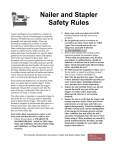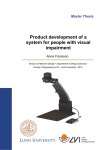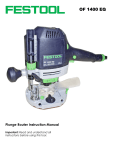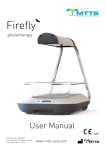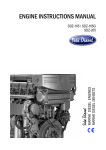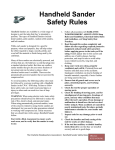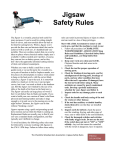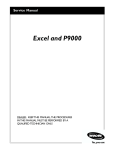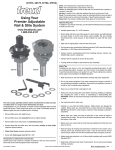Download Electric Drill Safety
Transcript
Electric Drill Safety Rules The Electric Drill is a handy tool in almost any shop. It’s handheld and portable. There are cordless models that give the user more freedom of movement and can be taken to places where electrical outlets aren’t available. There are models with adjustable clutches that target the market for users who need them as high-performance screwdrivers, and there are models that have an impact feature that provides enhanced ability to drill in difficult materials and some which are really oriented to use as impact wrenches often used by mechanics. Our primary focus will be on those used for drilling wood and possibly driving screws. It is worth knowing that the versions with the impact feature can do a much more effective job at these tasks in certain situations. The Electric Drill can be used to drill holes in a wide range of diameters, and with appropriate driver bits can be used to install or remove screws and bolts. As noted above some models have an adjustable torque setting so that screws can be set properly without being overdriven and damaging the material being secured. Electric Drills are rotating tools. They have the potential to grab and wrap hair, jewelry, fabric or similar material around a bit or even around the chuck. The danger from the chuck is increased on models using the common chuck key, which uses gear teeth to open and close the chuck. To avoid accidents, the following safety rules must be followed by everyone working with Electric Drills in the CWA / JPM shop. Failure to follow these safety rules can result in personal injury or injury to others and can result in a loss of shop privileges. Start with a Risk Assessment to ensure a safe work area, and that the machine is ready to use: 1. Follow all procedures in CHARLOTTE WOODWORKERS’ ASSOCIATION Shop Rules and Guidelines, Electrical Safety Rules 2. 3. 4. 5. 6. 7. 8. 9. 10. 11. 12. and Guidelines, and Shop Safety Best Practices. Keep your work area clean and well lit. Cluttered benches and dark areas invite accidents. Check the tool for proper operation of moving parts. Check for binding of moving parts, and for misalignment of moving parts, breakage of parts, and any other condition that may affect the tool’s operation. If damaged, have the tool serviced before using it. Many accidents are caused by poorly maintained tools. Develop a periodic maintenance schedule for your Electric Drill and follow it. Inspect tools for any damage prior to each use. Check the handle and body casing of the tool for cracks or other damage. If the tool has auxiliary or double handles, check them all to see that they are installed securely. Inspect cords for defects: check the power cord for cracking, fraying, wear, cuts or other faults in the cord insulation. Check for damaged switches and switches with faulty trigger locks. Do not use the tool if the switch does not turn it “ON” or “OFF” reliably. Any tool that cannot be controlled with the switch is dangerous; have it repaired. While checking that the switch turns the Electric Drill “On” and “Off” reliably, check the drill for excessive vibration. Do not use a drill that vibrates excessively or appears unsafe in any way. Inspect the plug for damage; including cracks and missing, loose, or faulty prongs. A damaged or malfunctioning part must be properly repaired or replaced prior to use to avoid risk of personal injury. The Charlotte Woodworkers Association | Electric Drill Safety Rules Effective 4/8/14 DP/WJ 13. Do not operate power tools in explosive atmospheres, such as in the presence of flammable liquids, gases or dust. Power tools create sparks which may ignite the dust or fumes. 14. Don’t operate corded drills in damp or wet locations. If operating the drill in a damp location is unavoidable, use a ground fault circuit interrupter (GFCI) protected supply to power the tool. Use of a GFCI protected supply reduces the risk of serious electric shock. Even with GFCI protection, AVOID RUNNING A CORDED ELECTRIC DRILL WHILE STANDING IN WATER!!! 15. Keep the area around where you’ll be working clear of people and debris that could impair your traction or footing to avoid potential slips and falls. 16. Drill bits and other drill accessories can be dangerous. You can injure yourself or a bystander if you aren’t careful where you’re holding them, even when the drill isn’t running. 17. Dress properly. Don’t wear loose clothing or jewelry. If a drill can catch anything while it’s running it will wrap it up until the bit stop turning. If you’re wearing jewelry such as necklaces, bracelets, or rings that could become caught or entangled in moving parts, remove them and store them safely. Roll up long sleeves, tuck in or remove ties, etc. 18. Don’t wear gloves. If you’re working in our shop environment it should never be too cold to work without gloves. If it is, ask a Shop Foreman to have someone turn on a heater. 19. Tie back, or otherwise secure, long hair. 20. Keep your hair and clothing away from moving parts. Loose clothes, jewelry, or long hair can be caught in any rotating part of the Electric Drill. 21. Keep handles dry, clean, and free from oil and grease. 22. Never carry the Electric Drill with your finger on the power switch (trigger). Carrying tools with your finger on the switch or plugging in tools that have the switch “ON” invites accidents. 23. Remove the chuck key, if your drill has one, and any adjusting keys and/or wrenches before turning the tool “ON”. A wrench, 24. 25. 26. 27. 28. chuck key, or an adjusting key that is left attached to a moving part of the tool can cause personal injury to the operator or a bystander. There’s also the possibility that it may damage the tool, the chuck key, adjusting key, or wrench. It could also damage the material being worked on. Use safety equipment. Always wear eye protection. Non-skid safety shoes, hard hat, and hearing protection must be used when situations call for them. Safety glasses (ANSI Z87.1) and (CAN/CSA Z94.3) with side shields or a face shield must be worn. The impact resistance of everyday eyeglasses is not as great as the impact resistance that is necessary for eyeglasses to be classified as safety glasses. Both lenses and frames must pass specific tests to be classified as safety glasses. For more information on the requirements that eyewear must meet to be classified as safety glasses, see: http://www.allaboutvision.com/safety/safetyglasses.htm. If you’re not wearing actual safety glasses, wearing safety goggles over your regular glasses can provide the protection you need. Hearing protection should always be worn. Use the appropriate dust mask or respirator in dusty work conditions. Electric Drills can create dust and if your operation does, protection from that dust is important. Give the work your undivided attention. Operational Safety Rules: 1. Approach your work in the Shop & while using the Electric Drill with a safe attitude! 2. Read the manual of operating/safety instructions (User’s Manual) that came with the Electric Drill. If you can’t find it and if the Shop Foreman can’t help you find it, someone can download a copy of the manual from the internet. This manual should tell you where the various switches and controls for the Drill are and how they’re supposed to work. 3. If you don’t know how to use the Electric Drill properly for the work you plan to do, get instruction on how to use it correctly for what you want to do BEFORE beginning. 4. Keep bystanders, children, and visitors away from the work area while operating a power The Charlotte Woodworkers Association | Electric Drill Safety Rules Effective 4/8/14 DP/WJ 5. 6. 7. 8. 9. 10. tool. Having anybody not involved in the drilling operation in the immediate area can create distractions that can cause you to lose control of the tool. Stay alert, watch what you are doing and use common sense when operating a power tool. Do not use tools while tired or under the influence of drugs, alcohol, or medication. A moment of inattention while operating power tools may result in serious personal injury. Keep the Electric Drill’s air vents clear to maintain adequate airflow through the tool. Proper ventilation helps keep the drill from overheating while in use. Use the proper chuck key that fits the chuck correctly to tighten and loosen bits. Using chuck keys that don’t fit exactly right can damage the chuck and have the potential to slip while you’re tightening them which could result in injury. Always remove the drill bit when transporting or storing the Electric Drill. Removing the bit ensures that you won’t stab yourself, another woodworker, or a bystander with the bit. Even a dull bit can cause serious injury. Keep power cords away from the chuck, installed bits or accessories, heat, water and oil. When drilling or driving screws, or using the drill for any other operation, make sure you place the cord in such a way that you won’t damage it by accident. Be aware of the proper operation of the drill’s power switch. Generally these are trigger switches; on many models the trigger is a variable speed control, the further the trigger switch is depressed the higher the speed (within the limits of the drill’s maximum speed). It’s common for electric drills to have triggers that Lock. If your drill has a locking feature, become completely familiar and comfortable with the operation of the lock. If the switch is locked "ON" during use, be prepared for emergency situations by being ready to switch it "OFF". On some models this is done by first pulling the trigger then immediately releasing it, but other models may differ. Make sure you learn how yours works before you start using the drill. Make sure you try the procedure for unlocking the 11. 12. 13. 14. 15. 16. 17. power switch often enough to become totally comfortable with it. Leave it UNLOCKED BEFORE plugging the drill in. Always make sure that the switch is “OFF” before plugging the Electric Drill in or installing its battery pack. On drills with locking trigger switches, make sure the switch is “UNLOCKED” before plugging the tool in. Accidental start-ups can cause injury. Never unplug tools by pulling on the power cord. When unplugging equipment pull on the plug, not on the cord. Hold Electric Drills only by the handles when drilling into areas that may contain “live” wires. On most handheld power tools, Electric Drills included, contact with a "live" wire may make exposed metal parts of the tool "live", which can shock the operator. If possible, do not drill or cut into existing walls or other blind areas where electrical wiring may exist. If this situation is unavoidable, disconnect all fuses or circuit breakers feeding that part of the worksite before proceeding. Keep your hands and all other parts of your body, as well as those of any helper or assistant, at least 3 inches from any point where the drill bit, or drill chuck, may travel while you’re drilling. The same applies to the area where a screw or other fastener may emerge while you’re driving it through or into the workpiece. Do not reach under the material being drilled or where screws are being installed. The proximity of the bit (or screw) to a hand that’s under the material being drilled or joined is hidden from your sight. Caution all assistants to avoid putting any body part in the areas where drill bit or fastener may be traveling and warn them not to reach under the material being drilled or joined. Do not overreach. Keep proper footing and balance at all times. Proper footing and balance enables better control of the tool in unexpected situations. Unplug the Electric Drill or remove its battery pack before installing or changing bits or accessories. This reduces the chances of injuring yourself should you accidentally depress the power switch while performing these operations. The Charlotte Woodworkers Association | Electric Drill Safety Rules Effective 4/8/14 DP/WJ 18. Make sure the bit you’re installing is acceptable for use in the Electric Drill you’re planning to use. Acceptable Drill types and sizes for a given drill model and application should be available from the manufacturer, often in the user’s manual for your model of Electric Drill. An example of such a table can be found, for some Bosch Electric Drills on the internet at: http://mdm.boschwebservices.com/files/r18721 v2.pdf. 19. Do not use dull, bent or damaged bits. Bits that are in poor condition are basically just waiting to cause you further problems. Dull bits can be dangerous if the amount of pressure you apply while attempting to get them to cut causes the bit to break. If that happens the portion that breaks off can become a projectile. Bent or damaged bits won’t drill straight and this can cause a number of undesirable results, least of which is that the hole you’re attempting to drill will not be straight, true, and of the desired diameter. Sharpen, repair, or replace damaged bits rather than use them as they are. 20. Insert the drill bits into the drill chuck until they hit the “bottom” of the chuck, then back them out a little (1/8 inch should be enough) so they aren’t touching the “bottom” of the chuck and tighten them. Make sure that the jaws of the chuck close evenly around the bit, with the bit in the center of the jaws. This ensures that the bit will be centered and will be held firmly by the chuck jaws when they’re tightened. 21. Drill bits usually have one of two styles of shank. Either the shanks are round or they have a hex profile. Nut drivers, screw driver bits, and drivers for standard sockets intended for use with Electric Drills typically have a hex profile. Either type of shank will work in the standard 3-jaw chucks, but they must all be centered properly and the chuck must be properly tightened. 22. If you’re using the impact feature available on some Electric Drills, the bits you use must be rated for use in an impact drill/driver. Using standard bits in an impact driver can lead to damage to the bit and potential injury depending on what happens if the bit fails. 23. If your drill has an impact feature, it’s important to know if it’s on full time or if it can be selected. If the drill has impact capability, you need to know how it’s selected and how it’s turned on and off to properly configure the drill for the task you want to perform. It’s also important to be able to turn the impact function OFF if you’ll be using bits that aren’t impact rated. 24. There are two types of chuck tightening mechanisms on drills commonly seen in modern shops. The older method, still common, uses a chuck key. These are called “keyed chucks”. The newer method uses a keyless chuck, which can be tightened by hand. There are different variations of keyless chucks, but the concept is similar. Make sure that you know how your specific chuck tightens and loosens the installed bit. . Consulting the user’s manual for the model of drill you’re working with is the proper first step in learning how to work with your chuck for the first time. If you still have questions, you should ask the Shop Foreman to direct you to someone with the experience to help you use your style of chuck. 25. Most Electric Drills are variable speed tools; use the proper speed for the size and type of drill bit you’re using and for the material you’re working with. This is a situation where referring to the user’s manual that came with the drill you’re using would be wise. It’s also important to have information on the proper speed range to use with the bit you have installed. 26. The most common way that speed is controlled on Electric Drills is by how far the user depresses the trigger. In general, when adjusting the speed of the Electric Drill choose slower speeds for larger diameter holes and when cutting material that can be damaged by buildup of heat, such as plastics. Choose faster speeds for small diameter holes with bits that feed easily like standard twist drills. Familiarize yourself with the characteristics of different drill bit styles (twist bits, brad point bits, selffeeding bits, spade bits, hole saws, etc.) and the factors that influence the rate that each style of bit can cut. The Charlotte Woodworkers Association | Electric Drill Safety Rules Effective 4/8/14 DP/WJ 27. Understand how the Electric Drill you’re using controls speed. On most electric drills, this is done using the trigger switch as outlined above. Some models, however, have several speed ranges. They are usually variable speed drills but with different maximum speeds. Choosing the correct speed range is an important part of setting up the drill for safe use in your application. If you’ve never used this model of drill before, you can learn about speed controls and speed range selection from the user’s manual or from someone who’s familiar with the model of drill you’ll be using. If you can’t locate the user’s manual, and you don’t know someone with experience who can help you, contact the Shop Foreman and they’ll help you find someone who can help you find the manual or who can answer your questions on how to use this feature of the drill you plan to use. You need to understand the speed range of the drill you’ll be using and how to control those speeds in order to operate the drill efficiently and safely. 28. Most new Electric Drills have can reverse their direction of rotation. This allows tasks like removing screws to be accomplished easily. You should learn how the reversing feature works on your model of Electric Drill (with most it’s just a switch lever under the trigger). If you can’t determine how the drill’s direction of rotation is changed from the user’s manual, ask the Shop Foreman to help you find the assistance you need. 29. Dust collection for handheld Electric Drills is not common, but is available as an accessory for some brands, particularly for impact drivers. If your drilling application needs dust collection, please contact a Shop Foreman for assistance. 30. Use only accessories that are recommended by the manufacturer for your model of drill or that are approved for use with your specific Electric Drill model. Accessories that may be suitable for one model of a tool may become hazardous when used on another model. 31. Secure material before drilling. Secure and support the stock being drilled. If drilling through holes, the best results can be achieved by clamping the stock with a sacrificial backer 32. 33. 34. 35. 36. 37. board underneath so that the drill bit will exit the workpiece cleaning as it starts to cut into the backer board. NEVER support stock to be drilled by hand or with any part of your body (or an assistant’s body). Instead clamp it properly to an appropriate supporting surface and take steps so that you don’t drill into the support unless you plan to replace the support after use. Holding the work by hand or against your body is dangerous and unstable; taking that approach may lead to loss of control if the drill bit seizes in the hole while you’re drilling and could lead to serious injury. Make sure all supports, clamps and holding devices are clear of the drill bit’s path before continuing. Keep the stock clamped to the support until the drill bit has been withdrawn from the workpiece and the drill has stopped turning. Make certain that all locking adjustments are properly locked and the bit is secured properly before plugging the handheld Electric Drill in. Loose adjustments or drill bits can slip and cause loss of control. A general best practice is to lock each adjustment properly before moving on to the next task as you make the Electric Drill ready for drilling. NOTE: properly tightened means just that, follow the instructions in the user’s manual or other reliable reference. These parts can be over tightened too, so be sure you know how tight is “properly” tightened. Before starting to drill a hole, carefully locate the hole’s center, mark it for easy reference and, if necessary to properly locate the starting point for the drill bit, mark the center with an awl or sharp punch so that the bit will have an easy time remaining on center as you start drilling. This is more of an issue with standard twist bits than it is with bits with sharp center points like those found on Forstner and brad point bits. Most drill bits are sharp enough to cut you. Handle drill bits with care to avoid injury. The sharp edges of most drill bits can be damaged if they are mishandled, dropped, or stored improperly. Handle drill bits with care and respect. Store them in the proper holders so that their edges are protected and don’t drop The Charlotte Woodworkers Association | Electric Drill Safety Rules Effective 4/8/14 DP/WJ 38. 39. 40. 41. 42. 43. them, especially on hard floors like the concrete floor in the shop. Keep a firm grip on the Electric Drill to maintain control and get the cleanest possible result. Firm means comfortably firm, not a knuckle whitening clenched grip. Do not force the Electric Drill. Let the bit cut at a rate where it is able to clear the chips well and where you don’t feel like you’re asking it to bore the hole faster than it’s able to cut without bogging down. If you’re using the right bit at the proper speed it should drill smoothly. The correct tool, properly configured, will do the job better and more safely at the rate it was designed for. If you’re having problems, contact the Shop Foreman who can help you determine what’s going wrong. Forcing a bit to cut faster than it’s able to will result in poor cut quality and can result in broken bits when using smaller diameter (less than 1/4 inch) bits and can be a serious safety issue with larger bits if the bit catches and twists the drill from your hands. Before making any adjustments, performing maintenance, changing accessories, or changing bits, turn the Electric Drill “OFF”, let it come to a complete stop, then unplug it or remove the battery pack. Such preventive safety measures reduce the risk of starting the tool accidentally. When removing drill bits after the drill has been running, do so with CARE! Woodworking and metalworking bits are SHARP, and after you’ve been using the drill for a while, they can be HOT! When removing the bit from the Electric Drill do so with care to avoid cutting, and possibly burning, yourself. Some dust created by power sanding, sawing, and grinding, drilling, and other construction activities contains chemicals known to cause cancer, birth defects or other reproductive harm. Some examples of these chemicals are: • Lead from lead-based paints • Crystalline silica from bricks, cement and other masonry materials • Arsenic and chromium from chemically treated lumber 44. 45. 46. 47. 48. 49. 50. Your risk from these exposures varies, depending on how often you do this type of work. To reduce your exposure to these chemicals: work in a well ventilated area, and work with approved safety equipment, such as those dust masks that are specially designed to filter out microscopic particles. Never abuse the power cord on corded tools. Never use the cord to carry the Electric Drill. Maintain tools with care. Keep the tools clean and in good repair and keep drill bits clean and sharp. Properly maintained tools, with sharp bits, are less likely to bind and are easier to control. Any alteration or modification of the Electric Drill is considered misuse and may result in a dangerous condition. Inspect your stock carefully before drilling. Stock should be clean, free of dirt and other debris, and not have metal fasteners of any kind in the area that will be drilled unless you’re deliberately drill those areas with a metal cutting drill bit. Never place any part of your body directly in line with the drill bit’s path. If you do, eventually you’ll end up drilling a hole in yourself!!! That is painful at a minimum and could be fatal at worst. STOP the drill and wait until the bit has come to a complete stop before moving the workpiece or clearing sawdust and chips by hand or with a brush. This is much safer than working around a moving drill bit. Do not drill a workpiece that is too small to be safely supported and held securely. If you have small parts that need to have holes drilled in them and you don’t know how to hold them safely while drilling ask the Shop Foreman to help you find someone who can assist you. There are so many ways to safely hold material for drilling that someone will almost always be able to provide a good recommendation that will allow you to hold the work safely for drilling. When taking a break or when finished using the drill for the day, unplug the Electric Drill or remove the battery pack, remove the bit and store the drill and all its accessories properly, out of the reach of children and The Charlotte Woodworkers Association | Electric Drill Safety Rules Effective 4/8/14 DP/WJ other untrained persons. Tools are dangerous in the hands of untrained users. 51. Before storing the Electric Drill for the day, clean it to remove sawdust so that it will be free of debris when the next person wants to use it. Coil the cord neatly (if it has one), and then store it properly. Maintenance and Service 1. Tool service must be performed only by qualified repair personnel. Service or maintenance performed by unqualified personnel could result in a risk of injury. For example, internal wires may be misplaced or pinched. If a tool belonging to CWA or our host organization needs maintenance, contact the Shop Foreman. If the tool is still under warranty, they will make arrangements for the service to be done under the warranty. If the manufacturer’s warranty has expired, they will ensure that the tool is repaired by properly qualified repair personnel. 2. When servicing a tool, use only identical replacement parts. Follow instructions in the Maintenance section of the manual applicable to that make and model of tool. Use of unauthorized parts or failure to follow the correct maintenance instructions may create a risk of electric shock or injury. Certain cleaning agents such as gasoline, carbon tetrachloride, ammonia, etc. may damage plastic parts. Before using chemical cleaning agents on a tool check the manual for that make and model of tool for approved cleansers and cleaning procedures. The Charlotte Woodworkers Association | Electric Drill Safety Rules Effective 4/8/14 DP/WJ







